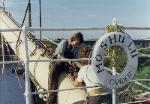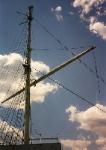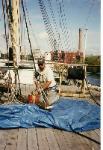
| Barque Moshulu |
In the spring of 1995, I was hired to re-rigged the Moshulu. The legendary Moshulu , a four-masted Barque of 3,200 tons gross, was built by
William Hamilton & Co., Glasgow, Scotland in 1904 for the G.J.H. Siemers Co. of Hamburg , Germany. Originally launched as the KURT, this
state of the art sailing ship was the finest and latest of man's achievements in the world's shipbuilding industry. The vessel has a length of 335 feet
at the waterline, a beam of 47 feet and a depth of hold 28. She was heavily constructed and sparred for the long and arduous passage around Cape
Horn. When World War I broke out, Siemers ordered the Kurt to remain in port (Astoria, Oregon) for the duration to be safe from British
cruisers. When the United States entered the war , the Kurt was appropriated by the U.S. Government. The Kurt was first renamed the
Dreadnought and then the Moshulu by Mrs. Woodrow Wilson. The Moshulu sailed under the American flag until 1935 when she was bought by
Gustaf Erickson. It was under Gustaf Erickson's ownership that she took part in the famous "grain races" of the 1930's. After a passage from
Buenos Aires in 1939, the Moshulu lay in Kristiansand, Norway, a nation that was occupied by Nazi forces. In November of 1942, she was towed
to Oslo fjord and at the orders of the German military command was rigged down.
Moshulu was used as a floating warehouse into the 1950's until she was purchased by the Finnish State Granary in 1957 to become a grain storage
hulk in Finland. In the 1970's , she was discovered by Capt. Raymond E. Wallace in the bay of Nantalia, Finland. Capt. Wallace contacted David
Tallichet of Specialty Restaurants Corp. Mr. Tallichet purchased the Moshulu to be used as a restaurant-museum. A shipyard in Scheveningen,
Holland, was contracted to fabricate masts, yards and standing rigging as merely a "show rig" as designed by Capt. Wallace. This "show rig" was
much lighter than her original rolled , riveted and tapered spars. The standing rig was also sized down and of 6x19 wire rather than the original 6x7
wire construction. After the shipyard period, she was towed across the Atlantic to first South Street, New York, then to Penn's Landing in
Philadelphia, Pennsylvania. Moshulu thus began her new career as a restaurant.
In the late 1980's a fire broke out in the electrical control room. Fire and smoke/water damage resulted in the closing down of the restaurant. While
Moshulu languished in her burnt out state, she was vandalized and stripped of a lot of her gear. Her rigging began to deteriorate, climaxed by the
crashing to deck of her fore lower and upper topsail yards after the lifts carried away.
The ship was in a very sorry state, with yards swinging on broken brace wires. In fact the 2 1/2 ton fore upper topsail had parted its lifts and
crashed to deck, denting the upper side of the fore yard on the way down.
The following items are some of the issues that were faced in the re rigging of the Moshulu.
- Use of 2 flat wire seizings and 2 fiber flat seizings instead of using 4 round wire seizings on shrouds and backstays.
- The time involved in turning in 3/16" wire round seizings was cut by 75%. The safety factor was not compromised due to the built in
redundancy of multiple shrouds and backstays. After applying a test wire flat seizing using 3/16" galvanized annealed 1x7 wire, a 3 ton chain
fall was bent onto the tail and loaded up. No movement or racking was observed in the seizing. Since this rig would not be loaded with high
sail generated forces, the 2 flat wire seizings with 2 flat fiber are within the safety parameters. The flat fiber seizings were made out of black
3/16' polypropylene. The fiber seizings were used since they required only one person to be clapped on unlike the wire seizings that required
two people.
- Use of 4 round wire seizings on all stays
- Since the stays were single with no built in redundancy, 4 round seizins were needed to achieve the safety factor desired.
- Use of 80 grit sandpaper to scuff up galvanized wire foot ropes
- Properly wormed, parceled and served foot ropes were not used to save money. The time it would take to worm, parcel and serve 36 foot
ropes was substantial. Use of slippery bare galvanized wire foot ropes was a safety concern. By scuffing the galvanizing a rust "tooth" was
created to prevent slipping.
- Bottlescrews used as dumb sheaves.
- The bottle screws and solid thimbles in the rig were all deteriorated and full of rust and scale. This was caused by not using an anti-seizing
grease when first rigged in Holland along with a lack of maintenance. Almost every bottlescrew had water in the lower body of the bottle,
which over time froze up all the bottle screws. After using an oxygen/acetylene torch and a 6 foot cheater bar to break the upper and lower
threads free, only 29 out of a total of 140 bottle screws were successfully broken loose with the upper and lower threads free to turn. Out
of the remaining 111 bottle screws , 96 had upper threads free to turn and the lower threads frozen solid, another 15 were frozen solid at
both upper and lower threads. To apply tension to the rig it was necessary to use one good bottlescrew on the forward shroud in a gang and
on all the stays. A Burton pendent was rigged from the lower futtock palm on each mast with a 1.5 ton chain fall bent on to it. The tail of
the turn back of the stay, shroud, or backstay was clapped on to the chain fall and then hauled upon until the wire was tight. The use of
tallow around the solid thimbles helped the wire render around. The wire and fiber seizings were then clapped on. The final tuning of the rig
required the upper eye of the bottle screws with frozen lower threads to be loosened and not tightened, since the laying up of the wire more
than counteracted the opening up of the bottlescrew. The use of non historic 5/8" galvanized steel round stock as ratlines tied everything
together by firming up the rig.
- Shorten and plug weld fore, main, and mizzen topgallant/royal masts.
- Several years ago, the fore, main, and mizzen topgallant/royal masts were cut down with an oxygen/acetylene torch. The cuts, very rough
and uneven, were made just above the cap iron while a shore-side crane was hooked up to the mast. After the cutting, the mast section
above the cap iron was place on deck. The heel of the mast was left in the doubling. The mast heels could not be struck to deck due to the
steel fids being rusted solid in place and the fact that there was a large pad eye at the topmast head for crossing the upper topsail yard in it's
raise position if desired (there a no halyards or tye chains rigged on any yard, only pseudo crane fittings). The heels were about 14 feet long.
Sleeving the mast above the cap iron where the weight of the steel lower and upper topgallant and royal yards would bear solely on the
welded sleeve with no additional support given by the doubling, was a major safety concern of mine The combined weight of the topgallant
and royal yards was over 9,500 pounds. To sleeve the mast above the cap iron would also involve the added expense of hiring a crane, since
the heel could not be struck to deck using ship's gear. I wanted the plug welded sleeve to be below the cap iron so the doubling would give
the sleeved mast extra support and bury. This method was decided upon after consultation with a structural engineer. This method,
however, required the lower topgallant yard to be crossed at the doubling instead of the cap iron. To make it easier for the welders, the heels
were cut off at 5 feet above the cross trees. Doing this allowed the welders to stand on the trees in addition to not having to rig staging at
the masthead. A sleeve was plug welded to the topgallant mast on shore. The mast was then raised by a shore side crane and lowered into
the cap iron and plug welded to the heel.
- Turnbuckle preventer slings on lower and upper topsail, lower and upper topgallant, and royal yards.
- Since the Moshulu had a recent history of spars crashing to deck and since the new owners had the misplaced idea that they could use an
off-duty waiter with a tarbrush to look after the rig, yard preventer slings became a safety item. No rig is maintenance-free, as we in the
ship restoration game know all too well. Preventer slings were fabricated out of a turnbuckle/pad eye combination. Pad eyes were welded on
the mast above the yard cranes and at the sling of the yard with the turnbuckle spanning the two. By taking some tension on the turnbuckle
some of the strain on the yard lifts and cranes was relieved.
Length: 335.3 feet / 102.2 mtr
Beam: 46.9 feet / 14.3 mtr
Draft: 26.6 feet / 8.1 mtr
Gross/Net Weight: 3109 / 2875 tons
Deadweight: 5300 tons
Beam: 46.9 feet / 14.3 mtr
Draft: 26.6 feet / 8.1 mtr
Gross/Net Weight: 3109 / 2875 tons
Deadweight: 5300 tons
Moshulu 1945
| February 1995 |
| June 1997 |
| Halcyon days 1938 |
| Hajo Knuttel on the right and myself on my first day aboard. |
| Bending on sail during the "Last Grain Race" - a wonderful book by Eric Newby |

| Rounding Cape Horn 1938 & Cocktails 1998 |
| Photo Gallery |
Fore deckhouse being rebuilt.
This deckhouse also served as
the office and nerve center for
the rigging gang
This deckhouse also served as
the office and nerve center for
the rigging gang
The 'tween decks - this
was a great area to set up
block rebuilding and
painting.
was a great area to set up
block rebuilding and
painting.
One of over 300 wire
rope splices
rope splices
Rattling down
Applying cellouse slurry insulation
between the frame bays
between the frame bays
The bent fore lower topsail
crane pin. This pin was over
1.5" thick and was damaged
when the fore upper topsail
yard fell from the rig a year
before the rigging restoration
began.
crane pin. This pin was over
1.5" thick and was damaged
when the fore upper topsail
yard fell from the rig a year
before the rigging restoration
began.
The infamous coal pile that
would frustrate painting efforts -
if the wind shifted.
would frustrate painting efforts -
if the wind shifted.
Coal dust on deck and
everywhere
everywhere
Jim Brink splicing
in the office
in the office
More rattling down. On a 4
masted Barque there are a lot
of ratlines!
masted Barque there are a lot
of ratlines!
Tarbrush, aka Chris Janninin
and Judd turning in seizings.
The portable outboard staging
worked great
and Judd turning in seizings.
The portable outboard staging
worked great
Rigger extrodinaire Jim Barry
priming some of his handiwork
priming some of his handiwork
Temporary steel pipe
belaying pins welded to
the rail flange awaiting
the wooden rails to be
installed
belaying pins welded to
the rail flange awaiting
the wooden rails to be
installed
Chuck Ertle and his wife Babs painting
The rigging gang
Looking back at the rig
after crossing the last yard
after crossing the last yard
The Before and After
| Crew member Berndt Hilbertin skylarking on the fore royal truck 200' above the water while underway in 1939 |



















































